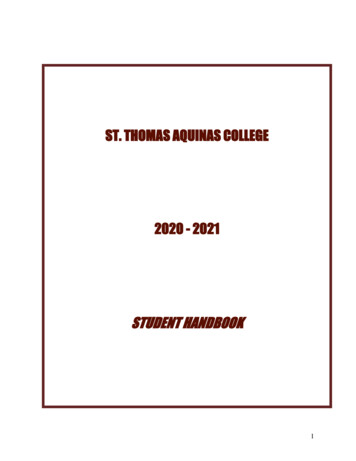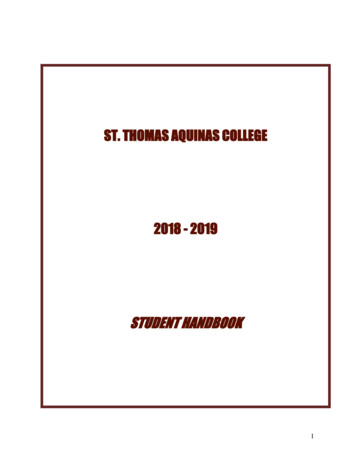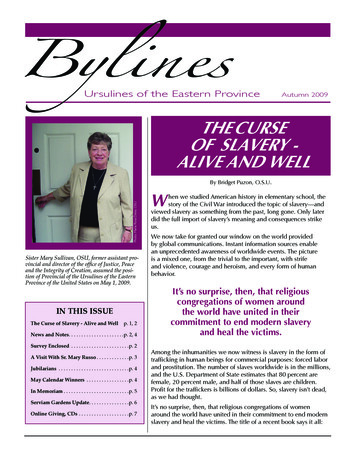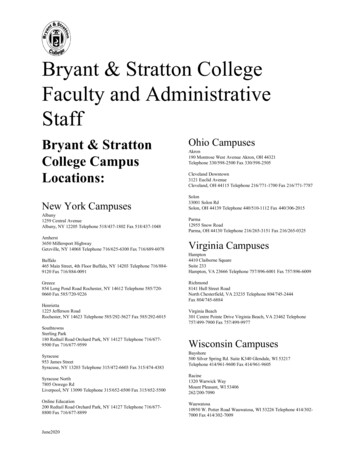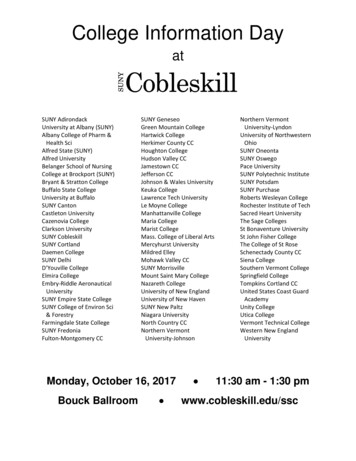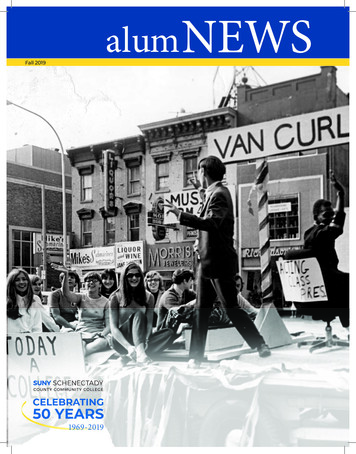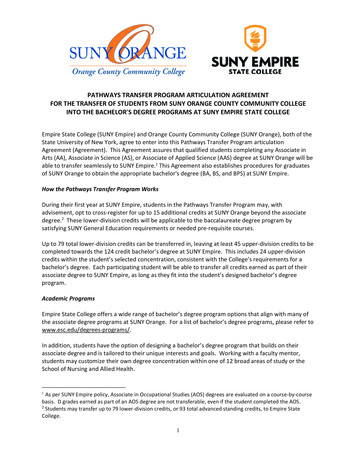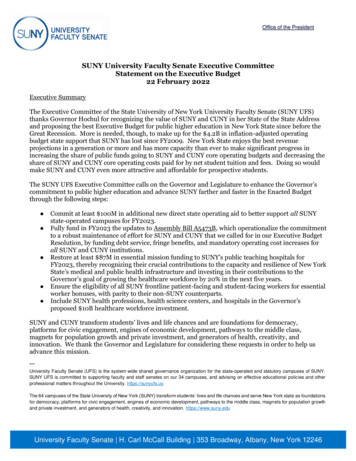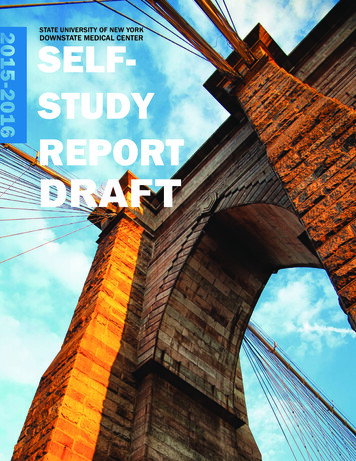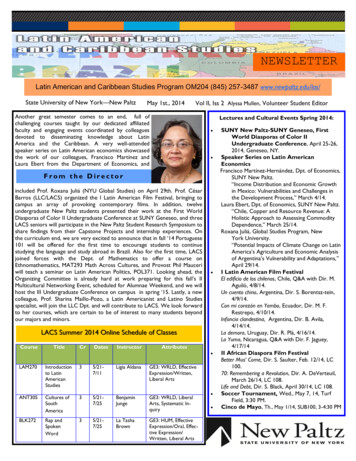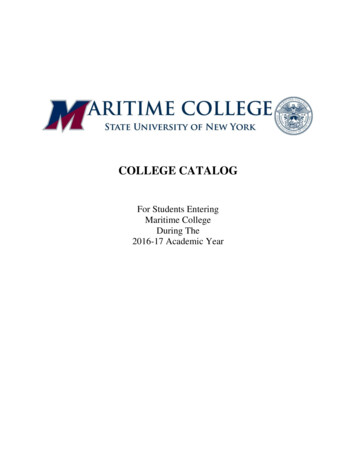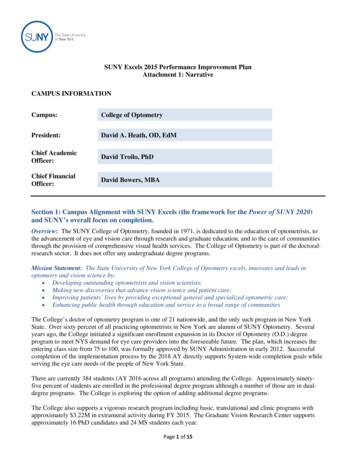
Transcription
SUNY Excels 2015 Performance Improvement PlanAttachment 1: NarrativeCAMPUS INFORMATIONCampus:College of OptometryPresident:David A. Heath, OD, EdMChief AcademicOfficer:David Troilo, PhDChief FinancialOfficer:David Bowers, MBASection 1: Campus Alignment with SUNY Excels (the framework for the Power of SUNY 2020)and SUNY’s overall focus on completion.Overview: The SUNY College of Optometry, founded in 1971, is dedicated to the education of optometrists, tothe advancement of eye and vision care through research and graduate education, and to the care of communitiesthrough the provision of comprehensive visual health services. The College of Optometry is part of the doctoralresearch sector. It does not offer any undergraduate degree programs.Mission Statement: The State University of New York College of Optometry excels, innovates and leads inoptometry and vision science by: Developing outstanding optometrists and vision scientists; Making new discoveries that advance vision science and patient care; Improving patients’ lives by providing exceptional general and specialized optometric care; Enhancing public health through education and service to a broad range of communitiesThe College’s doctor of optometry program is one of 21 nationwide, and the only such program in New YorkState. Over sixty percent of all practicing optometrists in New York are alumni of SUNY Optometry. Severalyears ago, the College initiated a significant enrollment expansion in its Doctor of Optometry (O.D.) degreeprogram to meet NYS demand for eye care providers into the foreseeable future. The plan, which increases theentering class size from 75 to 100, was formally approved by SUNY Administration in early 2012. Successfulcompletion of the implementation process by the 2018 AY directly supports System-wide completion goals whileserving the eye care needs of the people of New York State.There are currently 384 students (AY 2016 across all programs) attending the College. Approximately ninetyfive percent of students are enrolled in the professional degree program although a number of those are in dualdegree programs. The College is exploring the option of adding additional degree programs.The College also supports a vigorous research program including basic, translational and clinic programs withapproximately 3.22M in extramural activity during FY 2015. The Graduate Vision Research Center supportsapproximately 16 PhD candidates and 24 MS students each year.Page 1 of 15
The College’s University Eye Center (Article 28 Diagnostic & Treatment Center) provides vital vision careservices to the New York City community with approximately 70,000 patient visits per year. An additional80,000 patient encounters involve students, residents and faculty providing care through affiliated clinicalpartners in the community (hospitals, health centers, etc.).International Programs: The College also has strong international links to China and supports the Power ofSUNY 2020’s big idea: SUNY and The World. In partnership with the Wenzhou Medical University and theChinese Government, the college provides international study opportunities for its students, partners in a Centerof Excellence in Low Vision & Vision Rehabilitation in Wenzhou, China and hosts a Confucius Institutespecializing in health care. The College has more recently begun working with the University of KwaZulu-Natalin Durban, South Africa on practitioner education and this year is piloting an advanced standing program foroptometrists and physicians trained abroad.Alumni/Philanthropy: The College successfully concluded a 10M campaign, (The Vision & the Promise),October 1, 2014. This was the first formal campaign in the history of the College and its success holds promisefor the future. The College is currently working to build upon the Campaign’s success and improve its annualfundraising operation. We have set a target of doubling the percentage of alumni giving annually by 2020. Weanticipate the next major campaign will coincide with the College’s 50th Anniversary in 2021.Strategic Plan & Alignment: The College is guided by its strategic plan, “2013-2018 Strategic Plan: A Legacyof Leadership”, (http://www.sunyopt.edu/2013 strategic plan/), which is proactively managed through acomprehensive Institutional Assessment Plan approved in July 2013, (http://www.sunyopt.edu/offices/institutional research/assessment plan). (Also included as PDF Attachments 1 & 2.)The College conducts a major review of its strategic plan every five years, while monitoring progress on acontinual basis. The last major review occurred during the 2012-2013 Academic Year with final endorsement bythe College Council on June 3, 2013. The College’s Strategic Plan contains 11 goals with correspondingobjectives: Each goal is explicitly linked to the six big ideas of the Power of SUNY 2020.Key elements (among others) of the strategic plan that align with The Power of SUNY 2020’s six big ideas andSUNY Excels include: Increasing enrollment in the Doctor of Optometry degree program to meet eye care workforce needs inNew York. (Healthier New York, The Entrepreneurial Century – Access, Completion, Engagement)Enrolling a highly qualified and diverse student body. (A Healthier New York - Access, Completion)Making the University Eye Center more accessible to the public within the context of health care reformand expanded educational programming. (A Healthier New York, A Vibrant Community, TheEntrepreneurial Century - Engagement, Completion, Success (applied learning))Expanding external clinical training opportunities within the health care systems of NYC and beyond.(Healthier New York – Access, Completion, Engagement)Developing new areas of research that are synergistic with the College’s existing research community.(The Entrepreneurial Century, A Healthier New York – Inquiry, Success, Access)Strengthening and expanding programs the train clinician scientists. (The Entrepreneurial Century, AHealthier New York – Access, Completion, Success, Inquiry)Creating additional learning opportunities for meaningful campus and civic engagement (A VibrantCommunity, The World, The Entrepreneurial Century – Success, Engagement)Assessment: In support of the strategic planning process, the College of Optometry has developed acomprehensive Institutional Assessment Plan. Various assessment strategies are used to track implementation ofthe strategic plan and monitor College operations. The primary motivation is to identify, obtain, analyze, and useoutcomes data for meaningful program improvement. The assessment plan includes a comprehensive listing ofmetrics collected by the college including key measures linked to the College’s Strategic Plan. Many of thesePage 2 of 15
metrics are published on the College’s website (http://www.sunyopt.edu/offices/institutional research/factbook).Within the College’s key metrics there are numerous indicators that align with SUNY Excels.The alignment of the College’s Strategic Plan with the Power of SUNY 2020 and SUNY Excels will be readilyapparent in Section 2 of this performance plan.SUNY Expanded Performance & Investment Fund: The College submitted three Phase 1 proposals for supportfrom the SUNY Expanded Investment and Performance Fund. All three were deemed eligible for furtherconsideration. The three proposals are:1) Developing Innovative Clinical Education Paradigms for Healthcare Reform - The SUNY College ofOptometry is requesting 2 million in funding from a combination of “SUNY 2020 Round V” and the“Investment and Performance Fund” to pilot a fundamental redesign of its patient care and clinical educationprogram using a 3,000 square foot portion of the University Eye Center’s primary care floor. The redesign,while supporting our 30% increase in enrollment, will develop an exemplary patient care unit that will ensureeffective and efficient eye care as well as better prepare optometrists for the effective management of chronicdiseases through care coordination, team-based interprofessional care and the promotion of wellness. (ExcelsLinks: Access, Completion, Engagement, Success/Applied Learning.)2) Virtual Reality and Simulation Laboratories - The intent of this project is to support the College’s 30%increase in enrollment/completion in the Doctor of Optometry degree program by increasing the capacity ofthe clinical education process and assuring in-depth exposure to an array of clinical conditions, includingthose with broad population health implications. The use of VR technology serves as an effective bridgepreparing students for the applied learning experience of the patient care setting and will enhance theirtechnical abilities, knowledge and critical thinking skills. (Excels Links: Access, Completion,Success/Applied Learning)3) Faculty Position in Cellular/Molecular Ocular Physiology – this application to the Empire InnovationsProgram is to obtain assistance in the recruitment of a leading cell and molecular biologist, performingresearch in ocular physiology, and who will fill a critical and complementary role within our researchcommunity. We seek a leader in the field to conduct a funded research program at the College and developcollaborations with our other faculty researchers, including translational and clinical projects with our ClinicalVision Research Center. This position represents a vital step toward meeting our research (Inquiry) goals ofincreasing sponsored activity at the College, expanding educational opportunity and collaboration through theSUNY Eye Institute and SUNY Networks of Excellence. (Excels Links: Inquiry, Access, Engagement)Endorsement: The College Council of the SUNY College of Optometry reviewed and endorsed the submission ofthis plan at its meeting on 16 September 2015.Section 2: Specific SUNY Excels Priority Areas and Metrics2.1AccessOverview: The implementation of the College’s 2012 Enrollment Management Plan specifically links to SUNYExcels - Access. The expansion of the professional degree program was based upon a workforce analysisconducted by the College’s Center for Vision Care Policy to assure that NYS has an adequate supply of highlyqualified eye care providers in the future. The plan’s implementation strategy specifically targeted increasing theenrollment of New York residents by expanding and revitalizing our partnerships with other SUNY campusesacross the state. Similarly, redesign of our Collegiate Science and Technology Entry Program (C-Step) enhancedour efforts to attract under-served minorities into health care professions generally and optometry specifically.The efforts have increased both the enrollment of New Yorkers and improved our ability to attract a diversestudent body. The College will continue the Enrollment Management Plan until it is fully implemented with theclass entering in the fall of 2017. Enrolling New York residents and a more diverse student body continue to bepriorities.Page 3 of 15
2.1.1 Full Enrollment Picture: The College’s projected enrollment growth starting in AY 2011 (303) goingthrough AY 2020 (399) is on track to achieve a 30% increase. This growth is a result of implementation of theCollege’s 2012 Enrollment Management Plan. Capital improvement projects have modified the instructionalfacilities to permit enrollment of 100 new doctor of optometry students per year (up from 75) making ourenrollment amongst the highest of any publicly funded optometry college. We are in the process of makingneeded improvements, structurally and programmatically, within the College’s patient care facility (the UniversityEye Center) to effectively accommodate the increased class size. The College’s commitment to graduating asufficient number of practitioners to meet the eye care needs of the State of New York must be balanced by theneed to assure all graduates are highly qualified to provide eye care services.The College of Optometry offers one of the strongest Doctor of Optometry (O.D.) degree programs in thecountry. In a highly competitive recruitment market the college is expanding its enrollment by 30% whilemaintaining all quality indicators. This is evidenced by the profile of the entering classes and the performance ofour students on national board licensing examinations.Profile - Entering Fall of:Entering Class SizeOverall Class GPAPre-Req's Class GPATotal Science Class .353532009 200878763.503.503.42 3.383663612007723.413.35361The College’s average performance on the Optometry Admissions Test (OAT) has been the second highest in thecountry (200 – 400 scale; National average of accepted students 316) while the average entering GPA is amongthe top five programs (21 programs nationally). Most students enrolling have completed a Pre-Med Bachelor’sdegree program. Several students participate in a 3-4 programs through which they are awarded a bachelor’sdegree from their undergraduate institution after the successful completion of the first year of the professionaloptometry program: Nine of these programs are with SUNY campuses.All optometry students take a three-part nationalboard examination (NBEO) prior to graduation.Passage is required for licensure. SUNY College ofOptometry students have been highly successful inpassing all parts of the NBEO prior to graduation(97%), well above the national average.The College’s graduate research program offers M.S. and Ph.D. degrees in Vision Science. The program hasbecome increasingly competitive and there has been recent growth in the number of applications with 28applications for 2 positions available for the fall of 2015. For AY 16 the College will have 24 MS and 16 Ph.D.degree students. Enrollment in these programs will be largely dictated by continued growth in the College’sresearch program.Page 4 of 15
Historic Enrollment (Professional and Graduate 20042006200820102012201420162018PlannedActualFig: Overall enrollment of the SUNY College of Optometry since its inception in 1971.Further growth in the professional OD program beyond what is already planned would not be consistent with theresults of the workforce study that justified the current expansion of the program and would require approval fromthe Accreditation Council on Optometric Education, the optometry program’s specialized accreditation agency.2.1.2 NYS Residents Served by SUNY: The expanded enrollment of the College of Optometry providesadditional opportunities for NYS residents to pursue a career in optometry. The College’s 2012 EnrollmentManagement Plan specifically considered provider shortage areas in upstate NY in its recruitment strategy andsimilarly in guiding new graduates as they consider practice opportunities. The College’s recruitment effortsupstate include increased visits and the development of formal inter-campus relationships including an increasedfocus on 3 – 4 programs with other SUNY institutions. The number of NYS residents enrolled at the College hasincreased 27% over the past five years (Attachment 2 - Table 4).2.1.3 Diversity: During the 2014 academic year, the College’s student body profile was 73% female, 43.8%minority (all) and 10.2% underrepresented minority (Attachment 2 - Table 5). According to the SUNY DataWarehouse, among the 64 SUNY campuses, the College of Optometry has the fourth highest representation ofminority and international students representing 51.2% of total enrollment. Notably, doctoral-level healthprofessions program have historically had difficulty in increasing the number of enrolled under-representedminority students. While the college has a high level of cultural/ethnic diversity among its students and is wellabove the average for its sector (doctoral-research – 29.7%), it continues to be challenged in its efforts to increasethe number of underrepresented minority students. The College is investing in its diversity efforts. The Collegereceives State support for its C-Step program; has established the position of Director of Minority Recruitmentand Enrichment and in recent years expanded student support services with the creation of the College’s Centerfor Career Development.2.1.4 Capacity: The College is already using workforce study data to align its enrollment and infrastructurecapacity with the supply of and demand for eye care providers in NYS. The ongoing expansion of enrollmentwill achieve that alignment.Access Summary – Future Plans & Investment: To increase access the College of Optometry will continue todevote its energy and resources to Completing the expansion of the doctor of optometry program by increasing the entering class size from75 to 100 (33% increase); Increasing the enrollment of underrepresented minorities into the professional degree program; Increasing its graduate degree enrollment secondary to expanded research programming; and Conducting a study to examine the feasibility and desirability of offering additional degree programs thatcomplement the College’s core mission and supports the System-wide Access and Completion goals.Access Summary - Key Performance Measures:Page 5 of 15
Have a total enrollment in degree granting programs of 400 or more by 2020 Have a diverse student body with minorities (all) representing between 40 – 45% of students. Complete a feasibility analysis examining the potential expansion of degree granting programs at theCollege2.2CompletionOverview: Increasing completion may be achieved by expanding enrollment or by improving the percentage ofstudents who complete the program in a timely manner. The College of Optometry’s professional degreeprograms has a consistently high completion rate (95% /-). It is unlikely that our completion rate can beimproved, thus our commitment to increasing completion is linked to the expansion in enrollment and thepotential initiation of new programming.2.2.1 Completion: The College of Optometry anticipates that by 2020 it will have expanded its totalcompletion numbers for the 2015 AY by over 30%.Degrees Awarded by Year120100806040200MSPhDOD Doctor of Optometry Degree program: In June 2015, the College awarded 74 Doctor of Optometrydegrees. With the full implementation of the Enrollment Management Plan, we anticipate that by 2020the number of OD degrees will increase 30% to an average of 94 annually. Graduate Research (MS, PhD): There are currently 16 PhD candidates (FT & PT) and 18 MS student(with an additional 5 – 6 to be admitted mid-year). The MS students are concurrently enrolled in the ODdegree program. Over the past 5 years, we have awarded an average of 3 PhD and 5 MS degrees eachyear. Certificates: The College of Optometry and Empire State College have entered into an agreement toprovide the College’s professional degree students with an opportunity to earn an MBA. The first phaseis the Advanced Graduate Certificate in Optometry Business Management which may be earnedcommensurate with the 4-year OD Program. The program began with the 2014 AY. We anticipate thatthe number of certificate completions by 2020 will be 8 – 10 annually. Students successfully completingthe certificate program may then automatically be admitted into Empire State’s MBA in Health CareLeadership program. Residency Education: The College trains 36 Residents per year through the College’s University EyeCenter and other affiliated clinical sites, (VAMC, Hospitals, Health Centers, etc.). Optometry residenciesare one year in length and residents receive Certificates of Advanced Competency upon the successfulcompletion of the program. The number of positions increased from 32 in 2010 to the current 36. Weanticipate having 41 training slots by 2020.2.2.2 Student Achievement / Success (SAM): The SAM program targets undergraduate programs thus theCollege of Optometry is not a participant. The college does however have multiple measures of success includingnational licensing exam data, graduating student exit surveys and surveys of alumni six years after graduation.Page 6 of 15
2.2.3 Graduation Rates/Time to Degree: Approximately 95% of College of Optometry students completetheir Doctor of Optometry degree within a five year period. This is not an area in which significant improvementcan be achieved.Completion Summary – Future Plans & Investment: Consistent with its 2013 – 2015 Strategic Plan, the Collegewill substantively contribute to the System-wide Completion goal by Graduating more Doctors of Optometry through the full implementation of the enrollment managementplan; Achieving enrollment goals (8-10 student per year) in the Advanced Graduate Certificate in OptometricBusiness Management; Increasing graduate research enrollments, secondary to expansion of the College’s research programs; and Expanding Residency Education Program by 15% through affiliations with external health care entities.Completion Summary - Key Performance Measures: The College will increase the number of degrees granted by 30% by 2020. The College will increase the number of certificate programs completed by 15% by 2020.2.3SuccessOverview: Similarly to “Completion”, we measure most of the variables associated with Success. Importantly,Applied Learning in the health professions has always been an integral part of educational program design:100% of professional degree students participate in a variety patient care settings for well over 2000 hours prior tograduation. All graduate research programs require hands-on research activity as well.Other examples of some key “Success” measures/programs at Optometry include: 95% 0f those admitted complete their degrees and do it within five years (Progression)Virtually a 100% employment rate (Employment)A nearly 0% default rate (financial literacy)One of the highest performance rates on the national licensing exams in the country. (Credentials &Learning)International clinical education opportunities (China) and volunteer mission trips to developing countries.(Multi-cultural)Students provide eye care (under the supervision of licensed practitioners) to a highly racially andethnically diverse clinical population (multi-cultural)Hosting a Confucius Institute for Health to encourage Cultural Exchange (Multi-Cultural)The College collects data on student engagement annually through its annual Student Exit Survey.Student participation in the delivery of Patient Care (Community Service), while being an applied learningstrategy, is more critically a central feature of health professions education. The College’s Article 28 patient careunit, the University Eye Center (UEC), is a key strength of the institution and is projected to support 70,000 patient visits this year in its 42nd St. facility. As one of the largest out-patient eye care facilities in the country, theUEC offers an unparalleled array of services including adult and pediatric primary care, contact lens care forcosmetic and medically necessary indications, refractive surgery, ocular imaging services, specialized oculardisease management clinics, low vision rehabilitation, traumatic brain injury (TBI) vision rehabilitation, visiontherapy, vision care services for learning disabled children and adults, along with services for children withspecial needs (multiple handicapped). The UEC opened its new Sports and Performance Vision Center on June 1,2015. While the infrastructure of the UEC has been adequate, to accommodate increased enrollment and providean applied learning experience that reflects the future of eye care, the College will need to invest in majorrenovations to the UEC facility and acquire significant clinical equipment and information technology upgradesover the next several years.In addition to the UEC, the College of Optometry has an established network of over 50 external clinicalaffiliates (see Engagement). With the implementation of the Affordable Care Act (ACA) and the NYS DSRIPPage 7 of 15
program, the College is expanding its collaborations within health care systems in New York and is a participantin several Performing Provider Systems (PPS). The expansion of affiliated sites will 1) increase clinical trainingopportunities to accommodate increased enrollment, 2) prepare students for an increasingly integrated and teambase health care model, and 3) provide needed eye care services to the NYC community.The College’s commitment to serving the community is strong. Charitable programs include Vision Screeningsin NYC schools, community-based institutions/agencies, Homebound Care, provision of Support Groups, anIndigent Patient fund, and community education. Students also volunteer both in New York and through visioncare missions to developing countries, while also serving as advocates for health, (Vision Walk, World VisionDay, etc.).2.3.1 SUNY Advantage: The College places substantial emphasis on enhanced curricular and co-curricularopportunities. Examples include the following: Applied learning through the College’s patient care facility – The University Eye Center. Applied learning opportunities available through the college’s affiliated clinical care sites which includemedical centers, hospitals, community health centers and other practice settings providing students with arich array of educational opportunities in eye care. The 2011 establishment of our Career Development Center, which supports the preparation and transitionof graduates into the professional workforce. In conjunction with Empire State, the development of an advanced graduate certificate program inoptometric business management that can be completed in conjunction with the OD degree. Creditsearned in this program may be directly applied toward a MBA in Healthcare Leadership from SUNYEmpire that may be earned pre- or post-graduation. A National Institutes of Health T-35 training grant supports the research activities of optometry studentsthrough summer stipends and direct research support A combined OD-MS program that allows optometry students to earn simultaneously both an OD and MSin vision science2.3.2 Financial Literacy: The College’s student default rate on federal student loans couldn’t be lower than it iscurrently: approximately 0%. Nonetheless, we recognize that student debt will continue to increase and maynegatively impact perceived career options. We have been proactive in putting in place programs to mitigate thisand maintain as near as possible our current success in this area. Specific examples include: The College fully participates in SUNY Smart Track program for financial literacy. The Career Development Center that was described previously provides financial management coursesfor both personal and professional development. The advanced graduate certificate and MBA programs in optometric business management that wasdescribed previously Clinical externship rotations in private practices located throughout the State, which provide possiblepostgraduate employment opportunities Required coursework that covers business aspects of optometric practice and the health care deliverysystem Elective coursework in personal financial planning for the new optometristSuccess Summary – Future Plans and Development: The College intends to maintain its record of excellence inacademic and clinical program performance while increasing it educational capacity to accommodate theexpanded enrollment. Specific plans related to the System-wide success goal include Investment in the renovation of the University Eye Center and acquisition of new clinical technologies toensure a) an appropriate applied learning experience for the doctor of optometry degree students; b)increased patient care capacity and quality of care for those served; and c) to provide a platform for theexpansion of the clinical research program. Investing in the expansion of clinical partnerships (hospitals & health centers) within the health caresystem of New York and participating as a partner in NYS DSRIP PPS programs;Page 8 of 15
Increasing co-curricular opportunities (including programs enhancing financial literacy) offered by theCenter for Career Development; Expanding of international clinical education opportunities; and Enhancing opportunities for student participation in research;Success Summary – Key Performance Measures: Renovation and Capital Investment in the University Eye Centero Square footage of clinical space renovatedo Investment in and acquisition of clinical equipment and technology Investment in and acquisition ofclinical equipment and technologyo Number of patients cared for (measure of clinical capacity and student education)o Clinical Research Activity (Indirect measure of impact) Expanding the number of clinical affiliations and external student rotations into multi-disciplinary, teambased health care settings One hundred percent (100%) of students will continue to have applied learning experiences as integralpart of their educational program Default rate on federal student loans to maintained at 1% or less Student participation rates in activities offered by the Center for Career Development Student participation in basic, translational and clinical research2.4InquiryOverview: The College of Optometry is a doctoral-research center with basic, translational and clinical researchprograms associated with healthcare. The SUNY Excel priority of Inquiry and its measures and initiatives are acentral part of our mission and one to which the College is strongly linked. The College’s strategic planestablishes ambitious goals for our research program and in particular the growth of the Clinical Vision ResearchCenter, which was formally established during the 2012-13 AY. A comparison of the Excel Performance SystemWorksheet with the College’s own assessment plan indicates that we are currently collecting virtually all of themeasures listed. The College pri
Section 1: Campus Alignment with SUNY Excels (the framework for the Power of SUNY 2020) and SUNY's overall focus on completion. Overview: The SUNY College of Optometry, founded in 1971, is dedicated to the education of optometrists, to the advancement of eye and vision care through research and graduate education, and to the care of communities
